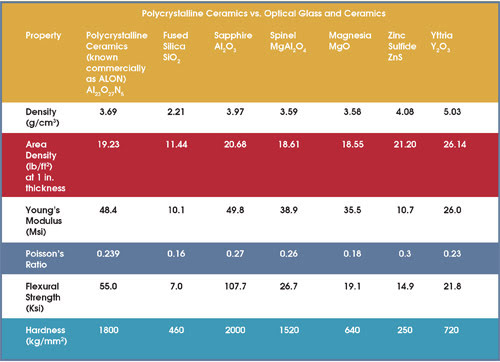Stronger yet cheaper than sapphire, new optical ceramics offer big weight savings.
Dr. Lee M. Goldman and Dr. Suri A. Sastri, Surmet Corp.
Stopping a projectile traveling at 2000 feet per second is no easy task. To do so, manufacturers of bullet-resistant glass rely on extra-thick glass and plastic laminates. But more thickness means added weight, which is not what you want when trying to speed away from enemy fire in an armored vehicle or a Humvee.
Enter polycrystalline ceramics. These new synthetic ceramics have the optical and mechanical properties of highly durable materials such as single-crystal sapphire, but can be manufactured to be very light in weight using standard low-cost powder-processing techniques.
Compared with conventional bullet-resistant glass, polycrystalline ceramics provide the same protection at half the weight and thickness. This results in hundreds of pounds of weight savings per vehicle, with the added benefit of better performance against the impact from multiple rounds.
The material’s proponents stress that it is not just for use in military applications. It can be used in numerous applications that demand toughness and optical clarity. Because polycrystalline ceramics can be formed into a number of complicated shapes and large sizes, they can be used in ways that would be impossible with competitive optical materials.
Potential uses for this material are being investigated. One use could be as domes on smart bombs and missiles. Polycrystalline ceramics boast a transparency range that stretches from the UV through the visible and into the infrared. This allows weapons systems designers to operate several guidance devices through the same dome, whether they are CCD-, radio frequency-, infrared- or laser-based. Specialists at the US Air Force Research Laboratory at Wright Patterson Air Force Base in Dayton, Ohio, are testing the ceramics for this application.
They also might be suitable as point-of-sale scanner windows. Given the extreme hardness and toughness of the ceramics, manufacturers see potential for everyday uses such as grocery store and retail scanners, where routine mishaps such as a dropped can of soup can damage expensive equipment.
The electronics industry also might find this material beneficial for making components. Polycrystalline ceramics have demonstrated excellent durability when exposed to corrosive chemical processes, making them candidates for plasma delivery tubes, wafer carriers, showerheads and process enclosures, such as envelopes and windows.
Processing and finishing
Polycrystalline ceramics, which have a defect cubic spinel crystal structure, are formed by adding a small amount of nitrogen to alumina. This converts the rhombohedral crystalline structure into a cubic spinel structure, which imbues the alumina with its isotropic optical properties. In other words, nitrogen stabilizes the cubic spinel crystal structure over a wide composition range.
The versatility of polycrystalline ceramics is tied to the fact that they can be produced with normal powder-processing techniques. Plates, domes, rods and tubes can be easily fabricated in a wide range of sizes, shapes and thicknesses.
The fabrication process begins with the synthesis of the optical-quality ceramic powder, which is made into a green body employing one of a number of forming techniques, including cold isostatic pressing, injection molding, slip casting or die pressing. A heat-treatment process then transforms the green body to 100 percent density.
After heat treatment, the fully dense ceramic is cut, ground and polished into a finished product more easily and in shorter time than is required for sapphire (one-half of the time for flat substrates and a quarter of the time for hemispherical shapes). This translates into lower costs for finished components than for the comparable sapphire parts (see table).
 Developed by Raytheon Co. for defense applications, the material, known commercially as ALON, or aluminum oxynitride, remained unknown to outsiders for many years. Given its proven features and benefits, Surmet Corp. of Burlington, Mass., acquired the rights to commercialize ALON. The company is manufacturing the material for defense applications such as missile domes and bulletproof transparent armor, and potentially for commercial applications such as grocery store scanners.
Developed by Raytheon Co. for defense applications, the material, known commercially as ALON, or aluminum oxynitride, remained unknown to outsiders for many years. Given its proven features and benefits, Surmet Corp. of Burlington, Mass., acquired the rights to commercialize ALON. The company is manufacturing the material for defense applications such as missile domes and bulletproof transparent armor, and potentially for commercial applications such as grocery store scanners.
So the next time you are in the checkout line at the supermarket, remember that crystal-clear and high-strength polycrystalline ceramics could be at work.
Meet the authors
Lee M. Goldman oversees the ALON Products Group at Surmet Corp. in Burlington, Mass.; e-mail: [email protected].
Suri A. Sastri, founder, chairman and CTO of Surmet Corp., headed Gillette’s Materials R&D laboratories for seven years and was the inventor of Platinum Plus coatings on premium products; e-mail: [email protected].